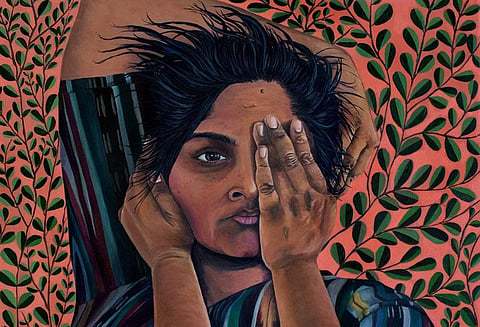

“Art allows us to reimagine realities and perceive things from another point of view, which, to me, are incredibly powerful tools to undo our biases and insecurities with,” says Chitra Gopalakrishnan, a graphic designer, artist and social entrepreneur from Kerala who has replanted herself and her work into the art scene in San Diego. She grew up between India and Kuwait, and she remembers collecting pieces of identity and inspiration in transit.
Chitra recollects high school. To her, it was a means to an end before she finally got the chance to pursue a career in design and art. Although she wasn’t always sure of what she wanted, she knew she wanted to steer clear of engineering, medicine and finance. It was a few classes in architecture that helped her stumble into graphic design.
The 40-year-old says, “Discovering this field felt like coming home and whatever I lacked in experience, I made up for with an absolutely wild drive to learn. The first few years of undergrad were very rough but I loved the work so much that I realised I had to figure out how to get better at it. This was all so long ago and so much has changed in my life, but my love for colour, line, texture and pattern has been a constant."
Following this, she pursued an MFA from Cranbrook Academy of Art in Michigan and ESAG Penninghen in Paris. About her designs, Chitra elaborates, “My work as a graphic designer and social entrepreneur have always been about telling the stories of people I am inspired by. When I started painting in 2017, this was the only subject I could naturally gravitate towards. It is always about people and their vulnerabilities.”
Chitra’s work has been celebrated in India and the US. Her most recognised piece was the Secret Garden series where she explored various issues of contemporary motherhood as it relates to the idea of freedom. At her new show at the Hill Street Country Club in California, she built in Augmented Reality animations that can be activated from viewers’ mobile devices. She says, “It has been so moving to see strangers enjoy these experiences I’ve built and safely view this during this time of heightened isolation.”
She shares a moment where she was jolted awake about her social responsibility: “When I had just started my undergraduate education, my grandfather asked me: How is this going to impact the people in our community? To a kid who was finally getting to practice what they loved most in the world, this was a very harsh question, and I remember being too upset to even answer him. Over the years, this has become the singular question that has driven the inquiry in my work. Design, art, business can all be so transformational if they are in the service of the community.”
Chitra’s work is almost always personal and autobiographical. She paints her own lived realities along with the stories of those around her. In fact, she describes her work as a diary entry or a time capsule of sorts to know what it was like to live in 2018 or 2021 as a person her identity (Huh?). She paints personal stories weaved in with tension and struggles that are all too familiar, making the personal universal.
The building blocks of this artist’s images are designs. While creating her signature work, she uses symbols, metaphors, analogies, colour theory, composition and perception. She describes her work as iterative and almost meditative. “When I build the images, I always seek ways to reward the viewer visually with layers and details when looking at the work very closely, as well as interesting compositions when looking at it from afar.”
Chitra was led by her lived experiences and perspective. She has learnt that the role of a designer has to be constantly outward-facing to positively impact those around oneself, especially at-risk communities. Inspired by this, she set up Kara Weaves, a network of traditional textile workers from around rural India, in 2007, with her mother and social anthropologist Indu Menon and actor Revathy Menon.
The idea was to set up a replicable model for anyone who wants to work with the vast network of artisan co-operatives in the country. Under the project, traditional artisanship, ethical trade practices and accessible design are made more accessible. Artisan co-op members work as collaborators, building a bridge for the most vulnerable communities.
